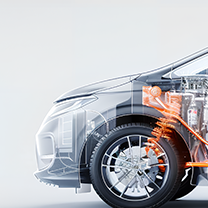
Products
Fast, Reliable, Everywhere

Solutions
Efficient, Innovative EV Charging Solutions.
The financial success of any DC fast-charging project hinges on a strategic site selection. From proximity to the power grid and regulatory hurdles to foot traffic and land stability, multiple factors shape a location’s earning potential.
The most profitable locations often align with specific demographic, logistical, and infrastructural traits. Investors must weigh these against budget constraints, user behaviors (en-route vs. destination charging), and future scalability.

Some typical indicators of a high-performing DC charging site include:
DC fast charging is already responsible for over 70% of the charging industry’s revenue and is on pace to become a $150 billion sector by 2030. With user demand surging, particularly for quick, convenient charging solutions, well-placed DC chargers are positioned to generate long-term profits.
However, location is arguably the most influential variable determining whether a charging station will thrive or falter. Let’s explore the key criteria that help ensure site profitability.
Before launching a new station, conduct a deep dive into local EV usage patterns and demographic trends.
EV drivers tend to be young, urban, and employed full-time. High EV adoption rates in your target region can signal existing demand. Heatmaps showing registered EVs by ZIP code or district are valuable tools for identifying customer density.
Tailoring your offering to local needs is also crucial. For instance, if there’s a nearby logistics hub operating electric fleets, consider configuring your site to accommodate heavy-duty vehicles and fleet managers’ charging cycles.
Proximity to major thoroughfares—like freeways, urban connectors, or busy intersections—can dramatically increase footfall. "En-route" charging stations cater to long-distance drivers, while "destination" stations benefit from being embedded in high-visit sites like:
Whether en-route or destination-based, traffic volume and visit duration should guide your planning.
Evaluate the level of competition in your desired area. Even in regions with existing EV infrastructure, there may be gaps—such as underserved locations for fast DC charging versus abundant slow AC chargers. Filling such gaps can set your station apart.
Research which services are already offered and whether competitors are targeting the same customer profile.
Some sites may look ideal on a map but prove unsuitable on the ground. Factors like unstable soil, high flood risk, or complex topography can derail otherwise promising investments. Additionally, high land leasing costs or competition from developers can complicate site acquisition.
Exploring multiple locations is essential, as the dropout rate for viable sites can be as high as 99%.
A robust and scalable grid connection is non-negotiable for DC fast-charging sites. Proximity to a substation reduces installation costs and complexity. Sites that are too remote or lack grid capacity may require expensive upgrades.
Apply for grid connections early, and ensure your energy demands (current and future) can be met. This step can take months and should be initiated in parallel with site scouting.
From zoning to environmental restrictions, every location brings its own regulatory landscape. Stay informed on regional frameworks such as Europe's AFIR guidelines or localized calibration laws.
Collaborate with municipalities and stakeholders early to streamline permit approvals and avoid costly delays.
Consider how easily you can staff the site if it includes value-added services (e.g., café, restrooms). Moreover, DC chargers need consistent monitoring and occasional onsite intervention—so accessibility for technicians matters.
Build with tomorrow in mind. EV demand is accelerating, and your station must be designed for eventual expansion. Whether you’re accommodating delivery fleets, e-buses, or higher-capacity batteries, leave space—both physically and electrically—for scaling.
Even a high-traffic site can become unprofitable if set-up costs spiral. Common expenses include:
Develop ROI projections early for every candidate site. This will help prioritize opportunities that offer reasonable payback timelines.
Don’t overlook secondary income opportunities: cafés, retail kiosks, ad placements, or data monetization can all supplement charging revenue.
Once the location is secured, focus on smart design. Optimize layout for easy navigation, visibility from the road, and a pleasant user journey. Adding lighting, canopies, and intuitive signage increases engagement and brand recall.
Consider amenities like:
Finding a profitable DC charging location is as much a science as it is an art. It involves weighing social behavior, technological feasibility, physical infrastructure, and financial forecasting—all at once.
To summarize, the top 10 considerations for identifying a winning location are:
A thorough, data-driven approach to site selection can help you unlock the full revenue potential of the booming EV fast-charging industry.
